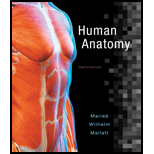
Human Anatomy (8th Edition)
8th Edition
ISBN: 9780134243818
Author: Elaine N. Marieb, Patricia Brady Wilhelm, Jon B. Mallatt
Publisher: PEARSON
expand_more
expand_more
format_list_bulleted
Concept explainers
Question
Chapter 20, Problem 12RQ
Summary Introduction
To determine:
The two vessels that are missing from the following sequence: Tracing the drainage of venous blood from the small intestine, blood enters the superior mesenteric vein, hepatic vein, inferior vena cava, and right atrium.
Introduction:
The intestinal venous blood is full of digested food and nutrients. Hepatic portal system is comprised of the hepatic portal vein, superior mesenteric, and splenic veins. This portal system carries digested nutrients from parts of the stomach, intestine, and transports it to the liver for further processing.
Expert Solution & Answer
Want to see the full answer?
Check out a sample textbook solution
Students have asked these similar questions
Please draw in the missing answer, thank you
Please fill in all blank questions, Thank you
please fill in missing parts , thank you
Chapter 20 Solutions
Human Anatomy (8th Edition)
Ch. 20 - What structural features of capillaries make them...Ch. 20 - Prob. 2CYUCh. 20 - Prob. 3CYUCh. 20 - Prob. 4CYUCh. 20 - Prob. 5CYUCh. 20 - Prob. 6CYUCh. 20 - Which vessel do you palpate to feel a pulse in...Ch. 20 - Name the vessels that branch off the abdominal...Ch. 20 - Prob. 9CYUCh. 20 - Prob. 10CYU
Ch. 20 - Prob. 11CYUCh. 20 - Prob. 12CYUCh. 20 - How does elevated blood glucose associated with...Ch. 20 - Prob. 14CYUCh. 20 - Prob. 15CYUCh. 20 - Prob. 1RQCh. 20 - Prob. 2RQCh. 20 - Prob. 3RQCh. 20 - Prob. 4RQCh. 20 - Which of the following vessels is bilaterally...Ch. 20 - Prob. 6RQCh. 20 - Prob. 7RQCh. 20 - Prob. 8RQCh. 20 - The following sequence traces the flow of...Ch. 20 - Prob. 10RQCh. 20 - The inferior mesenteric artery supplies the (a)...Ch. 20 - Prob. 12RQCh. 20 - Prob. 13RQCh. 20 - Prob. 14RQCh. 20 - Prob. 15RQCh. 20 - Prob. 16RQCh. 20 - (a) What structural features are responsible for...Ch. 20 - Prob. 18RQCh. 20 - Prob. 19RQCh. 20 - Sketch the arterial circle at the base of the...Ch. 20 - Prob. 21RQCh. 20 - Prob. 22RQCh. 20 - Prob. 23RQCh. 20 - Prob. 24RQCh. 20 - Differentiate between arteriosclerosis and...Ch. 20 - A pulse can be felt in the following arteries:...Ch. 20 - In an eighth-grade health class, the teacher...Ch. 20 - Prob. 2CRCAQCh. 20 - Prob. 3CRCAQCh. 20 - Prob. 4CRCAQCh. 20 - Prob. 5CRCAQCh. 20 - Prob. 6CRCAQCh. 20 - Occasionally, either the ductus arteriosus or the...Ch. 20 - Prob. 8CRCAQ
Knowledge Booster
Learn more about
Need a deep-dive on the concept behind this application? Look no further. Learn more about this topic, biology and related others by exploring similar questions and additional content below.Similar questions
- please draw in the answers, thank youarrow_forwarda. On this first grid, assume that the DNA and RNA templates are read left to right. DNA DNA mRNA codon tRNA anticodon polypeptide _strand strand C с A T G A U G C A TRP b. Now do this AGAIN assuming that the DNA and RNA templates are read right to left. DNA DNA strand strand C mRNA codon tRNA anticodon polypeptide 0 A T G A U G с A TRParrow_forwardplease answer all question below with the following answer choice, thank you!arrow_forward
- please draw in the answeres, thank youarrow_forwardA) What is being shown here?B) What is indicated by the RED arrow?C) What is indicated by the BLUE arrow?arrow_forwardPlease identify the curve shown below. What does this curve represent? Please identify A, B, C, D, and E (the orange oval). What is occurring in these regions?arrow_forward
- Please identify the test shown here. 1) What is the test? 2) What does the test indicate? How is it performed? What is CX? 3) Why might the test be performed in a clinical setting? GEN CZ CX CPZ PTZ CACarrow_forwardDetermine how much ATP would a cell produce when using fermentation of a 50 mM glucose solution?arrow_forwardDetermine how much ATP would a cell produce when using aerobic respiration of a 7 mM glucose solution?arrow_forward
- Determine how much ATP would a cell produce when using aerobic respiration to degrade one small protein molecule into 12 molecules of malic acid, how many ATP would that cell make? Malic acid is an intermediate in the Krebs cycle. Assume there is no other carbon source and no acetyl-CoA.arrow_forwardIdentify each of the major endocrine glandsarrow_forwardCome up with a few questions and answers for umbrella species, keystone species, redunant species, and aquatic keystone speciesarrow_forward
arrow_back_ios
SEE MORE QUESTIONS
arrow_forward_ios
Recommended textbooks for you
 Biology (MindTap Course List)BiologyISBN:9781337392938Author:Eldra Solomon, Charles Martin, Diana W. Martin, Linda R. BergPublisher:Cengage Learning
Biology (MindTap Course List)BiologyISBN:9781337392938Author:Eldra Solomon, Charles Martin, Diana W. Martin, Linda R. BergPublisher:Cengage Learning Fundamentals of Sectional Anatomy: An Imaging App...BiologyISBN:9781133960867Author:Denise L. LazoPublisher:Cengage Learning
Fundamentals of Sectional Anatomy: An Imaging App...BiologyISBN:9781133960867Author:Denise L. LazoPublisher:Cengage Learning Anatomy & PhysiologyBiologyISBN:9781938168130Author:Kelly A. Young, James A. Wise, Peter DeSaix, Dean H. Kruse, Brandon Poe, Eddie Johnson, Jody E. Johnson, Oksana Korol, J. Gordon Betts, Mark WomblePublisher:OpenStax College
Anatomy & PhysiologyBiologyISBN:9781938168130Author:Kelly A. Young, James A. Wise, Peter DeSaix, Dean H. Kruse, Brandon Poe, Eddie Johnson, Jody E. Johnson, Oksana Korol, J. Gordon Betts, Mark WomblePublisher:OpenStax College

Biology (MindTap Course List)
Biology
ISBN:9781337392938
Author:Eldra Solomon, Charles Martin, Diana W. Martin, Linda R. Berg
Publisher:Cengage Learning


Fundamentals of Sectional Anatomy: An Imaging App...
Biology
ISBN:9781133960867
Author:Denise L. Lazo
Publisher:Cengage Learning


Anatomy & Physiology
Biology
ISBN:9781938168130
Author:Kelly A. Young, James A. Wise, Peter DeSaix, Dean H. Kruse, Brandon Poe, Eddie Johnson, Jody E. Johnson, Oksana Korol, J. Gordon Betts, Mark Womble
Publisher:OpenStax College

Dissection Basics | Types and Tools; Author: BlueLink: University of Michigan Anatomy;https://www.youtube.com/watch?v=-_B17pTmzto;License: Standard youtube license